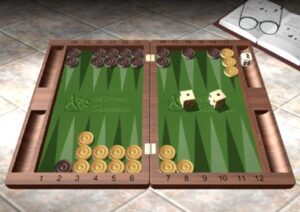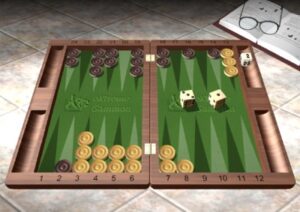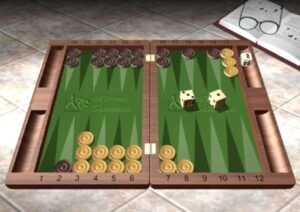Cash game, Black owns the cube.

White to play 1-1.
In this position, White has escaped his back checkers, while Black has a single checker remaining in White’s board, behind a 5-prime. How these positions are conducted depends on whether Black has one man back or two men anchored.
If Black is anchored, we name the position by the quality of the anchor: ace-point game, three-point game, and so forth. Those positions are fairly simple to conduct. White keeps his prime, brings his outside checkers home, clears the outside points of the prime, and finally starts to bear off. Keeping Black contained isn’t a big deal, because Black is usually so far behind in the race that he doesn’t want to run; keeping the anchor and trying for a shot is his best game plan.
If Black has only one man back, as here, the position has a different character. Now the race is often close, so keeping that one checker trapped is important. I call these positions “One-Way Primes”, to distinguish them from prime versus prime games, where both sides have checkers trapped behind primes.
White’s plan in a one-way priming game breaks down into three stages:
(1) Build a 6-prime, to keep the checker trapped.
(2) Roll the prime home and close out Black’s checker.
(3) Bear off safely.
Building a full 6-prime is White’s first job. If Black doesn’t have a prime of his own, this is a pretty straightforward process:
(1) If Black is at the edge of the 5-prime, hit him with any spares on top of the prime.
(2) If Black isn’t at the edge of the 5-prime, slot the prime from the back.
(3) Spread builders in the outfield to cover the rear of the prime.
For a more typical example, take a look at Position A.

Position A: White to play 3-1.
Here White has a 5-prime with the back of the prime already slotted. Black is at the front of the prime, ready to hop into the outfield, and Black is also 6 pips ahead in the race (94 to 100). Black’s home board is decent, but his 5-point is open, and he can’t build a prime of his own anytime soon.
Black’s racing lead combined with his home board gaps means that White should pursue a prime in the most direct way. The right play is simply 3/2* 13/10! White hits Black off the front of the prime while keeping the back of the prime slotted and giving himself a couple of cover numbers for the 8-point. If Black doesn’t roll a 2, White will complete a 6-prime with every number but 4-3 or 3-1. If Black does roll a 2, White needs to enter before Black rolls a 6, and he’s a big favorite to do that.
Why is making a full 6-prime so important? Why not just play safe, keep a 5-prime, and tip-toe home?
The power of a 6-prime is twofold: it renders the race moot, since Black can now never escape, and it creates a position that’s easy to roll home in more or less complete safety. Once you have a 6-prime, you just slot the front of the prime, cover the slot, then slot the new front of the prime, and repeat until you’ve rolled the prime completely home. Without a 6-prime, the process is more awkward and dangerous.
Suppose Black’s board is better than in Position A? What then? Take a look at Position B:

Position B: White to play 3-1.
With Black having both a 5-point board and a 5-prime, the position is now too dangerous to hit loose; the right play is 8/5, 13/12. Black is still an underdog to leap the prime, and White has double shots after 6-1, 6-2, 6-3, or 6-5. Only 6-6 and 6-4 are outright winners for Black. Study positions A and B carefully, because they represent the demarcation point between two separate plans of attack for White.
—–
Now let’s return to our original problem. Although Black’s position is the same as in Position B, White has a tactical trick available with his 1-1 roll that’s not possible with other rolls: He can hit without remaining exposed on the edge of the prime. The right idea is 3/2*/1, 13/11! Now Black’s only great shots are 1-1 and 2-6. Otherwise, hits on the 1-point leave Black needing a 1 and a 6 to escape, while White only needs to roll a 2 and then close his prime from the back. If Black rolls a 2 without hitting, White has all 5s and 3s (25 numbers) to complete a full prime.
The second-best alternative is the ugly-looking 3/2*(3) 8/7. While it gives up on the idea of making a prime, it does catch up in the race, and Black may take several moves to get to the 3-point and then escape, during which time he may fall further behind. Although it looks awful, it’s surprising close to the purer play in equity.





